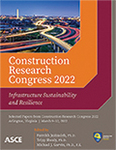Evaluation of Safe-to-Fail Criteria for Coastal City Flooding
Publication: Construction Research Congress 2022
ABSTRACT
Global warming and climate change are extreme weather phenomena that lead to an exponential increase in destructive hurricanes causing severe flooding and critical damage to infrastructure systems in coastal cities. It is critical to explore and adopt innovative and effective resilient design strategies such as Safe-to-Fail for infrastructure systems to reduce disaster damages. This study aims to (1) collect the Safe-to-Fail strategies from literature and aggregate them; and (2) evaluate the aggregated Safe-to-Fail criteria to determine the most suitable criteria for reinforcing infrastructure resilience in coastal cities. This study utilized a multi-criterion decision-making tool Analytical Hierarchy Process (AHP), and the resulting weights indicate that the highest-ranked criterion is Redundancy (38.88%), followed by Resource efficiency (24.35%), Adaptability (24.21%), and Multifunctionality (12.55%). The findings of this research facilitate the implementation of Safe-to-Fail infrastructure systems to mitigate flood risks and support decision-makers in selecting resilient flood solution alternatives, particularly for coastal cities.
Get full access to this article
View all available purchase options and get full access to this chapter.
REFERENCES
Ahern, J. (2011). “From fail-safe to safe-to-fail: Sustainability and resilience in the new urban world.” Landscape and Urban Planning, 100(4), 341–343.
Ahern, J. (2013). “Urban landscape sustainability and resilience: the promise and challenges of integrating ecology with urban planning and design.” Landscape Ecology, 28(6), 1203–1212.
Al Rasbi, O., Archer, H., Azizi, T. A., Bondank, E., Caccavale, R., Chepyala, N. R., Eisenberg, D., Elzomor, M., Gorman, B., Kim, Y., Klaas, M., Koride, S., Krantz, D., Langlois, C., Mishra, A., Musili, C., Muvva, V., Nassar, C., Parikh, U., Quintans, C., Santiago, R., Schattnik, K., Shah, K., Shinn, A., Sifferman, S., Slaymaker, A., Soneji, P., Taege, L., Thomas, C., Velez, D., Wang, K., and Zhang, X. (2016). Safe-to-Fail Adaptation Strategies for Phoenix-area Roadways Under Increasing Precipitation. 104.
Alshehri, S. A., Rezgui, Y., and Li, H. (2015). “Disaster community resilience assessment method: a consensus-based Delphi and AHP approach.” Natural Hazards, 78(1), 395–416.
Dunn, S., and Gonzalez-Otalora, S. (2021). “Development of an Adaptive Solution to Increase Infrastructure System Resilience Based upon a Location-Allocation Methodology.” Journal of Infrastructure Systems, 27(1), 04020043.
Hammond, M. J., Chen, A. S., Djordjević, S., Butler, D., and Mark, O. (2015). “Urban flood impact assessment: A state-of-the-art review.” Urban Water Journal, Taylor & Francis, 12(1), 14–29.
Harker, P. T., and Vargas, L. G. (1987). “The Theory of Ratio Scale Estimation: Saaty’s Analytic Hierarchy Process.” Management Science, 33(11), 1383–1403.
Kim, Y., Chester, M. V., Eisenberg, D. A., and Redman, C. L. (2019). “The Infrastructure Trolley Problem: Positioning Safe‐to‐fail Infrastructure for Climate Change Adaptation.” Earth’s Future, 2019EF001208.
Kim, Y., Eisenberg, D. A., Bondank, E. N., Chester, M. V., Mascaro, G., and Underwood, B. S. (2017). “Fail-safe and safe-to-fail adaptation: decision-making for urban flooding under climate change.” Climatic Change, 145(3–4), 397–412.
Möller, N., and Hansson, S. O. (2008). “Principles of engineering safety: Risk and uncertainty reduction.” Reliability Engineering & System Safety, 93(6), 798–805.
National Weather Service, Hydrologic Services. (2020). “NWS Hydrologic Services.” NOAA’s National Weather Service, <https://www.weather.gov/water/>(Feb. 22, 2021).
Orencio, P. M., and Fujii, M. (2012). “A localized disaster-resilience index to assess coastal communities based on an analytic hierarchy process (AHP).” International Journal of Disaster Risk Reduction, 3, 62–75.
Oswald Beiler, M. R., and Treat, C. (2015). “Integrating GIS and AHP to Prioritize Transportation Infrastructure Using Sustainability Metrics.” Journal of Infrastructure Systems, 21(3), 04014053.
Park, J., Seager, T. P., Rao, P. S. C., Convertino, M., and Linkov, I. (2013). “Integrating Risk and Resilience Approaches to Catastrophe Management in Engineering Systems.” Risk Analysis, 33(3), 356–367.
Pescaroli, G., and Alexander, D. (2015). A definition of cascading disasters and cascading effects: Going beyond the “toppling dominos ” metaphor.
Saaty, T. L. (1977). “A scaling method for priorities in hierarchical structures.” Journal of Mathematical Psychology, 15(3), 234–281.
Saaty, T. L. (1990). “How to make a decision: The Analytic Hierarchy Process.” European Journal of Operational Research, 48 (1), 9–26.
Saaty, T. L. (1994). “How to Make a Decision: The Analytic Hierarchy Process.” Interfaces, 24(6), 19–43.
Stanley, C. B. J. (2011). The Ecological Economics of Resilience: Designing a Safe-Fail Civilization. University of Waterloo.
Takala, J., Suwansaranyu, U., and Phusavat, K. (2006). “A proposed white‐collar workforce performance measurement framework.” Industrial Management & Data Systems, Emerald Group Publishing Limited, 106(5), 644–662.
Wakchaure, S. S., and Jha, K. N. (2012). “Determination of bridge health index using analytical hierarchy process.” Construction Management and Economics, 30(2), 133–149.
Wind, Y., and Saaty, T. L. (1980). “Marketing Applications of the Analytic Hierarchy Process.” Management Science, 26(7), 641–658.
Information & Authors
Information
Published In
History
Published online: Mar 7, 2022
Authors
Metrics & Citations
Metrics
Citations
Download citation
If you have the appropriate software installed, you can download article citation data to the citation manager of your choice. Simply select your manager software from the list below and click Download.
